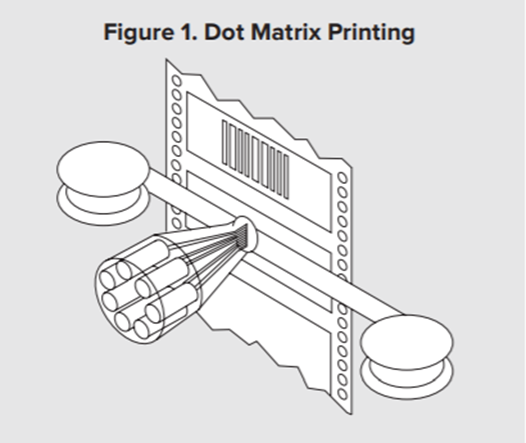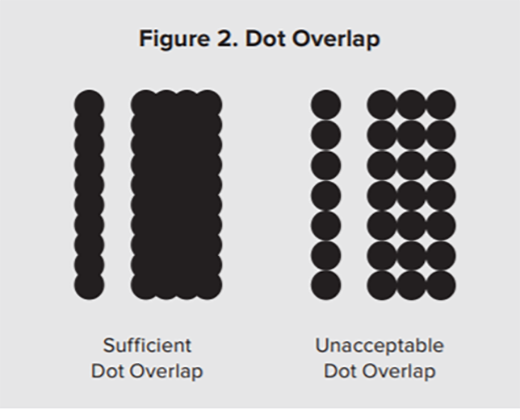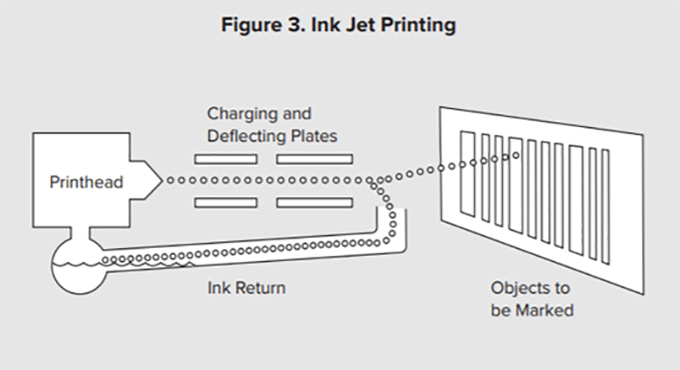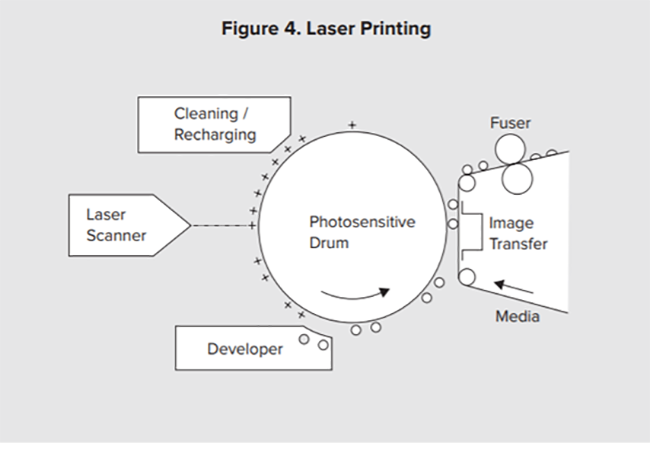On-Demand Vs. Pre-printed Labels
Thousands of companies have benefited from ordering preprinted barcode labels from service bureaus rather than investing in a barcoding system. Preprinted labels are useful in operations that require only a low volume of identical (i.e., fixed, non-variable data) labels, often with extensive use of colors or graphics.
However, companies that start with preprinted labels quickly discover the limitations of this solution option. Besides restricted flexibility, the use of preprinted labels prevents companies from including variable customer data or combinations of text and barcode information.
As a result, most companies find the financial commitment of printing on-demand barcodes worth the initial investment because of the added value from printing customized information on each label. For many applications requiring high-volume, mission-critical labels, the added cost of preprinted labels quickly exceeds the cost of the entire system. To the surprise of many barcoding novices, most of the companies that order preprinted labels also have barcoding systems. The preprinted labels are ordered with the necessary color, graphics or standardized text (such as return addresses on shipping labels) and are then fed through a barcode printer to receive customized (i.e., variable) information.
Whether a user elects to use preprinted or plain labels, media selection is critical to the success of any barcode integration. The variety of ribbons, paper, and synthetic labels and tags is too great for discussion in this document, but the barcode application, the intended life span of the label, and the environment to which the label will be exposed all have a direct impact on media selection. It is advisable to pretest a variety of media in an application before purchasing mass quantities.The variety of technologies available for barcode printing can be overwhelming. Further complicating the decision is whether it is better to invest in a barcoding system or to purchase pre-printed barcode labels.
Individuals new to barcoding often gravitate toward familiar technologies (such as laser printers, dot matrix printers or ink jet printers) that are already connected to a network and, therefore, deemed suitable for barcode labeling. While these printers can be used for some applications, they are often not the ideal solution for professional barcode labeling. The common limitations among these traditional office technologies include print speed and flexibility, as well as the inability to print labels that are durable enough or have the longevity or clarity required for all but the most basic barcoding applications.
What Is Dot Matrix Printing?
Dot matrix technology uses a hammer or pin to transfer pigment from a ribbon onto the substrate (see Figure 1). Due to the inaccuracy of dot placement and low resolution of the printing technology, these printers are nearly unusable for barcoding.
Advantages
- Dot matrix printers are readily accessible and inexpensive to purchase
They can print on virtually any type of form, check, or document and can print on wide-web, multipart (carbon) forms - Dot matrix printers use multi-pass ribbons, which can result in reduced overall cost for ribbons and label materials
Limitations
- Dot matrix printers print low- to medium-density barcodes that may not meet certain end-user guidelines. The dot size on the matrix printer limits the narrower element size and density of the barcode
- Continuous ribbon re-use on dot matrix printers requires close monitoring of ribbon condition to ensure adequate barcode contrast. Ribbon ink that has become exhausted can also produce an image that is inadequate for scanning, resulting in a low read rate and a high error rate
- Ink saturation can result in paper “bleed,” which can cause image distortion
- A dot matrix-printed label is limited in durability. Dot matrix printers typically cannot produce chemical- or water-resistant labels
- Printing of single labels results in significant waste. The design of the dot matrix printer’s print carriage, sitting far below the media, also does not allow the label space to be maximized
- Dot matrix printing offers no graphics printing capability
- Barcode print speed is greatly reduced when the best ink coverage for optimal print quality is specified


What is Inkjet Printing
Inkjet printing is used primarily for printing cartons or product packages with barcodes and human-readable data at very high speeds. Inkjet printers spray the ink onto the label surface in either a continuous stream, covering the entire print width with one spray, or one drop at a time (see Figure 3). However, inkjet printing is not acceptable for most barcoding applications.
Advantages
- Direct inkjet printing requires only one step, while label printing requires two: printing the label and adhering the label to the product
- High-speed inkjet printing is a favorite on high-speed production lines due to its ability to mark 'on-the-fly'
Limitations
- Inkjet printers are often too slow and are unable to reproduce barcodes with acceptable accuracy
- System installation is costly because it is designed for high-volume barcode printing—not for individual or small batch printing
- Inkjet printing requires diligent supervision and maintenance to ensure consistent print quality and prevent inkjet clogging
- Dot placement accuracy and barcode density/resolution are limited due to ink splatter and because the print surfaces are in continual motion
- Most inks used with this technology are water-based and, therefore, streak, run, or blur when they come in contact with water. Non-water-soluble inks are available, but these inks often produce a shine that reflects light back to the scanner, rendering the barcode unscannable
- Barcodes printed on the dark background of corrugated box materials suffer from poor contrast and poor readability
- Scanning devices must be carefully chosen to ensure reliable barcode reading

What is a Laser Printer
The laser printer works much like a photocopier; it projects controlled streams of ions onto the surface of a print drum, resulting in a charged image. The charged image then selectively attracts toner particles, transferring the image onto the paper substrate. After the image is transferred to the media, the heat and pressure of the fuser cause the image to adhere to the media.
Advantages
- Laser printers are good at producing plainpaper documents that require barcodes
- They can print high-quality text and graphics on paper documents and can double as a document printer when not being used to print barcodes
- Barcode density and resolution are also quite high on laser printers, resulting in a scannable code at virtually any wavelength using an infrared scanner
Limitations
- Laser printers are not well suited for industrial or individual-product labeling operations. They can be wasteful, as they cannot produce single or small labels. A minimum of half a page of media is typically required for the printer to maintain control of the sheet. Unless the label is at least that size or multiple labels are needed at once, the remainder is wasted.
- Laser printer label adhesives must be carefully selected to ensure stability under the heat and pressure of the fuser. Otherwise, the adhesive may extrude onto the printer mechanism where it captures stray toner, or may cause the labels to curl at the edges. Because of the pressures used in the laser printer image transfer process, many laminated label materials are not compatible with this technique. Those materials that are compatible may not always be available in the sheet form necessary for laser printing.
- Laser printing is susceptible to toner flaking and smudging, making the technology unsuitable for long-term barcoding.
- A laser-printed paper label has limited durability. For example, laser printers cannot produce chemical- or water-resistant labels and images.
- Toner, drum and supply costs can skyrocket when printing barcodes instead of typical text on laser printers. While text generally requires only about 5 percent black ink coverage, barcode needs can exceed 30 percent. Toner costs alone could be six times higher when printing barcodes rather than text.

Thermal Printing Technology
The most widely used technologies for dedicated barcoding systems are direct thermal and thermal transfer printing. While both technologies use a heated printhead to create the image on the label, they are suited to different applications.
There are two type of thermal printing technologies to print a barcode, direct thermal and thermal transfer. While there are distinct differences, in both cases heat is used for the print process. Direct thermal printing uses heat sensitive media, which is chemically treated, that blackens when passed under a thermal printhead. Conversely thermal transfer printing creates long-lasting images on various materials by using a heated ribbon in the process.
You can learn more about Direct Thermal and Thermal Transfer Printing by reading our dedicated FAQ which looks into the main differences between Direct Thermal and Thermal Transfer Printing.
Integrated Barcode Systems
Though the advance of barcoding has created new data management opportunities, much of the potential of barcodes remains untapped. Most barcode printers are connected to stand-alone personal computers (PCs) that control the barcode label design and function via a network print server. While these stand-alone systems, dubbed “island systems,” can still take advantage of barcode scanning to provide data automation, human users must direct the printer to print and manually enter nearly every piece of information.
More recently, enterprise resource planning (ERP) software has given barcoding an enhanced role in corporate information systems. In island systems, the barcode printer has no direct interaction with the corporate enterprise. When connected to an ERP system, the printer can take direction from other processes and print and encode data automatically when the server directs it to do so.
ERP systems, when used alone or partnered with warehouse management software or supply chain management applications, are capable of producing detailed reports based on the information they gather from the system operations. This reporting capability can be used with barcode integration software to print labels containing this same information.
Barcode Print Technology Matrix
| Technology | Print Quality | Scanner Readability | Initial Installation Cost | Long-Term Maintenance Cost | Materials Waste |
| Dot Matrix | Fair | Low | Low / Moderate | Moderate / High | High |
| Ink Jet | Moderate | Low / Moderate | High | Moderate / High | High |
| Laser | Moderate | Moderate | High | Moderate / High | High |
| Direct Thermal | Moderate / Excellent | Moderate / Excellent | Moderate / High | Low | Low |
| Thermal Transfer | Excellent | Excellent | Moderate / High | Low | Low |